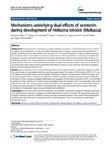Mechanisms underlying dual effects of serotonin during development of Helisoma trivolvis(Mollusca)
| dc.contributor.author | Glebov, Konstantin | |
| dc.contributor.author | Voronezhskaya, EE | |
| dc.contributor.author | Khabarova, MY | |
| dc.contributor.author | Ivashkin, E | |
| dc.contributor.author | Nezlin, LP | |
| dc.contributor.author | Ponimaskin, EG | |
| dc.date.accessioned | 2019-01-30T12:51:38Z | |
| dc.date.available | 2019-01-30T12:51:38Z | |
| dc.date.issued | 2014-12 | |
| dc.identifier.issn | 1471-213X | |
| dc.identifier.issn | 1471-213X | |
| dc.identifier.other | 14 | |
| dc.identifier.uri | http://hdl.handle.net/10026.1/13243 | |
| dc.description.abstract |
BACKGROUND: Serotonin (5-HT) is well known as widely distributed modulator of developmental processes in both vertebrates and invertebrates. It is also the earliest neurotransmitter to appear during neuronal development. In aquatic invertebrates, which have larvae in their life cycle, 5-HT is involved in regulation of stages transition including larval metamorphosis and settlement. However, molecular and cellular mechanisms underlying developmental transition in aquatic invertebrate species are yet poorly understood. Earlier we demonstrated that in larvae of freshwater molluscs and marine polychaetes, endogenous 5-HT released from the neurons of the apical sensory organ (ASO) in response to external stimuli retarded larval development at premetamorphic stages, and accelerated it at metamorphic stages. Here we used a freshwater snail Helisoma trivolvis to study molecular mechanisms underlying these dual developmental effects of 5-HT. RESULTS: Larval development of H. trivolvis includes transition from premetamorphic to metamorphic stages and shares the main features of metamorphosis with free-swimming aquatic larvae. Three types of 5-HT receptors (5-HT1-, 5-HT4- and 5-HT7-like) are functionally active at premetamorphic (trochophore, veliger) and metamorphic (veliconcha) stages, and expression patterns of these receptors and respective G proteins undergo coordinated changes during development. Stimulation of these receptors modulated cAMP-dependent regulation of cell divisions. Expression of 5-HT4- and 5-HT7-like receptors and their downstream Gs protein was down-regulated during the transition of pre- to metamorphic stage, while expression of 5-HT1 -like receptor and its downstream Gi protein was upregulated. In accordance with relative amount of these receptors, stimulation of 5-HTRs at premetamorphic stages induces developmental retardation, while their stimulation at metamorphic stages induces developmental acceleration. CONCLUSIONS: We present a novel molecular mechanism that underlies stage-specific changes in developmental tempo of H. trivolvis larvae in response to endogenous 5-HT produced by the neurons of the ASO. We suggest that consecutive changes in expression patterns of different receptors and their downstream partners in the course of larval development represent the molecular base of larval transition from premetamorphic (non-competent) to metamorphic (competent) state. | |
| dc.format.extent | 14- | |
| dc.format.medium | Electronic | |
| dc.language | en | |
| dc.language.iso | eng | |
| dc.publisher | Springer Science and Business Media LLC | |
| dc.subject | Serotonin receptors | |
| dc.subject | Helisoma trivolvis | |
| dc.subject | Development | |
| dc.subject | Metamorphosis | |
| dc.subject | Trochophore | |
| dc.subject | Larval competence | |
| dc.title | Mechanisms underlying dual effects of serotonin during development of Helisoma trivolvis(Mollusca) | |
| dc.type | journal-article | |
| dc.type | Journal Article | |
| dc.type | Research Support, Non-U.S. Gov't | |
| plymouth.author-url | https://www.webofscience.com/api/gateway?GWVersion=2&SrcApp=PARTNER_APP&SrcAuth=LinksAMR&KeyUT=WOS:000333514700001&DestLinkType=FullRecord&DestApp=ALL_WOS&UsrCustomerID=11bb513d99f797142bcfeffcc58ea008 | |
| plymouth.issue | 1 | |
| plymouth.volume | 14 | |
| plymouth.publication-status | Published | |
| plymouth.journal | BMC Developmental Biology | |
| dc.identifier.doi | 10.1186/1471-213x-14-14 | |
| plymouth.organisational-group | /Plymouth | |
| plymouth.organisational-group | /Plymouth/Faculty of Health | |
| plymouth.organisational-group | /Plymouth/Faculty of Health/Peninsula Medical School | |
| plymouth.organisational-group | /Plymouth/REF 2021 Researchers by UoA | |
| plymouth.organisational-group | /Plymouth/REF 2021 Researchers by UoA/UoA01 Clinical Medicine | |
| plymouth.organisational-group | /Plymouth/Users by role | |
| plymouth.organisational-group | /Plymouth/Users by role/Academics | |
| dc.publisher.place | England | |
| dcterms.dateAccepted | 2014-02-21 | |
| dc.identifier.eissn | 1471-213X | |
| dc.rights.embargoperiod | Not known | |
| rioxxterms.versionofrecord | 10.1186/1471-213x-14-14 | |
| rioxxterms.licenseref.uri | http://www.rioxx.net/licenses/all-rights-reserved | |
| rioxxterms.licenseref.startdate | 2014-03-13 | |
| rioxxterms.type | Journal Article/Review |


